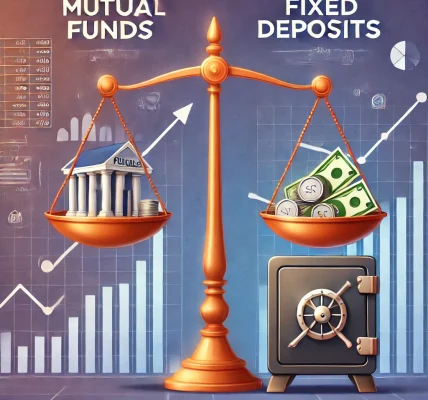Introduction
Mutual funds are a popular investment choice for both beginner and experienced investors. They provide a way to diversify investments, mitigate risks, and access professional management. However, the performance of mutual funds can vary significantly over time. Understanding the key factors that influence mutual fund performance is crucial for investors seeking to make informed decisions.
In this blog, we’ll explore the primary factors that impact mutual fund performance, so you can evaluate your investments and plan your portfolio effectively.
1. Market Conditions
The overall market environment plays a significant role in determining the performance of mutual funds. Economic factors such as inflation, interest rates, and market trends can influence how various sectors and asset classes perform.
- Bull Markets: In rising markets, equity mutual funds tend to perform better as stock prices increase.
- Bear Markets: Conversely, during market downturns, the performance of equity mutual funds may suffer. However, debt funds might perform relatively better during these times due to lower interest rates.
Pro Tip: Keep track of market trends and interest rate changes. Understanding how the market is moving can help you adjust your portfolio accordingly.
2. Fund Manager’s Expertise
The performance of a mutual fund is heavily influenced by the skill and expertise of the fund manager. A fund manager is responsible for making investment decisions, selecting stocks or bonds, and adjusting the portfolio based on market conditions.
- Active Funds: These funds rely on the manager’s skill to outperform the market. A highly experienced fund manager can significantly improve the fund’s performance.
- Passive Funds: These funds track market indices like the Nifty 50 or Sensex and are less dependent on the manager’s expertise.
Pro Tip: Research the track record of the fund manager before investing in an actively managed fund.
3. Asset Allocation and Diversification
Asset allocation refers to how a fund’s assets are distributed across different investment categories, such as equities, bonds, real estate, or commodities. A well-diversified portfolio can help mitigate risks and improve performance over the long term.
- Equity Funds: These funds invest primarily in stocks, offering the potential for high returns but come with higher risk.
- Debt Funds: Invest in fixed-income securities like bonds, offering more stability but lower returns.
- Hybrid Funds: These funds invest in a mix of equities and debt to balance risk and returns.
Pro Tip: Diversify your investments across asset classes to reduce risk and achieve more stable returns.
4. Expense Ratio
The expense ratio is the annual fee that the mutual fund charges to cover management and operational costs. A higher expense ratio means that more of the fund’s returns will be eaten up by fees, potentially affecting the fund’s overall performance.
- Low-Cost Funds: Index funds and exchange-traded funds (ETFs) typically have lower expense ratios compared to actively managed funds.
- High-Cost Funds: Actively managed funds may charge higher fees due to the costs associated with research, analysis, and management.
Pro Tip: Always compare expense ratios before choosing a fund. Even small differences in fees can compound over time.
5. Fund’s Investment Strategy
Each mutual fund follows a specific investment strategy. Some funds focus on growth, others on income generation, while some may focus on value investing or even socially responsible investing (SRI).
- Growth Funds: Focus on capital appreciation by investing in high-growth stocks.
- Income Funds: Invest in bonds or dividend-paying stocks to provide steady income.
- Sector-Specific Funds: Invest in specific sectors like technology, healthcare, or energy.
Pro Tip: Choose a fund whose strategy aligns with your investment goals, whether it’s for growth, income, or preservation of capital.
6. Past Performance
Although past performance is not always indicative of future results, it’s still an important factor to consider. Consistently high-performing funds might indicate good management and strong investment choices.
Pro Tip: Check a fund’s long-term track record rather than short-term performance. A fund with a solid history is more likely to continue performing well.
7. Fund Size
The size of a mutual fund, or its assets under management (AUM), can also affect its performance. Larger funds may face challenges in achieving the same level of returns as smaller funds due to the need to manage a larger pool of assets.
- Large Funds: May struggle to make big bets on growth stocks and could face liquidity issues.
- Small Funds: May be more nimble and able to take advantage of market opportunities.
Pro Tip: While larger funds have more stability, smaller funds can sometimes offer better opportunities for growth. Choose based on your risk tolerance.
8. Risk Management and Volatility
Mutual funds that employ effective risk management strategies tend to perform better over time, especially during periods of market volatility. A well-managed fund will adjust its portfolio to minimize potential losses while striving to achieve optimal returns.
- Low-Volatility Funds: Aim to preserve capital while providing moderate returns.
- High-Volatility Funds: Have the potential for higher returns but come with increased risk.
Pro Tip: Evaluate how the fund handles market downturns and its approach to managing risk.
Conclusion
The performance of mutual funds is influenced by a wide range of factors, from market conditions to the skill of the fund manager. To optimize your mutual fund investments, consider factors such as asset allocation, the expense ratio, the fund’s strategy, and past performance.
By keeping these key factors in mind, you can make more informed decisions and enhance your chances of achieving your financial goals. Remember to always align your mutual fund choices with your personal investment strategy and risk tolerance.




